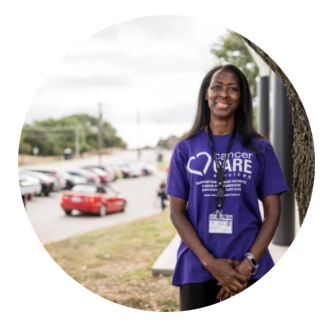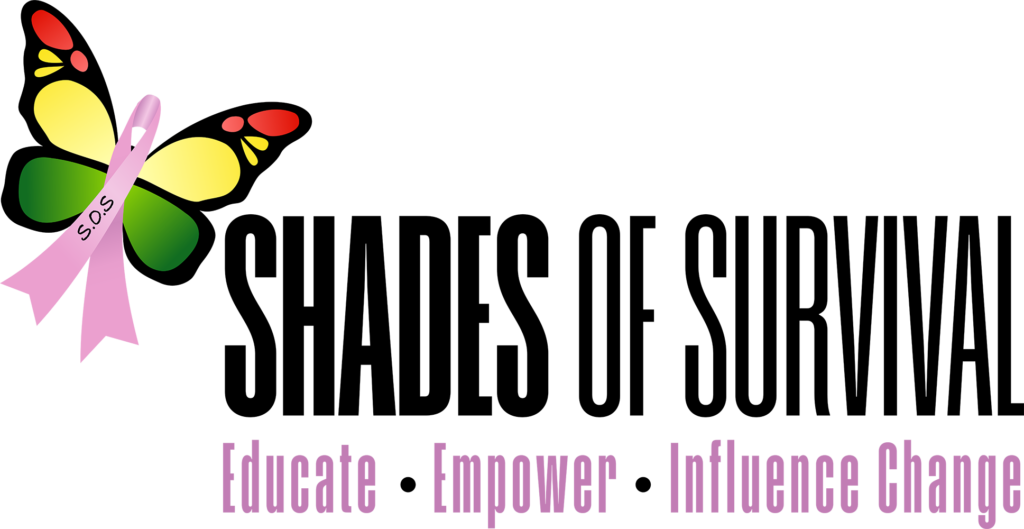
The woman in the third car outside of Las Vegas Trail Rise food pantry wanted to talk. It was about 9 a.m. on a Tuesday, and she was waiting in a food line that wouldn’t start moving for another hour.
She’s lost people to cancer and COVID-19 as recently as last weekend, she told Carlene King, the community health worker standing outside her driver’s side window. The woman wept, and King took her number.
She said she would call her later and refer her to Cancer Care Services, the nonprofit that employs King as a liaison between the community and the company: “This is why I do what I do.”
The interaction took three minutes, maybe four, a moment of intimacy amid rolled-up windows and language barriers and people who didn’t want to chat about cancer while they waited for food.
A similar moment occurred two days before at a church across town. Fatu Holloway, a community health worker at Tarrant County Public Health, was giving a presentation for Birdville ISD about the county’s Women, Infants and Children program, which provides nutritional services to pregnant women, new moms and their children. A woman and her pregnant teenage daughter listened nearby, Holloway remembers.
The woman looked “lost,” she said. Afterward, they spoke. Holloway told her where to find baby things like diapers and car seats for free. The next day, the woman texted Holloway: She’d made an appointment for a car seat and wanted to let her know.
“I’m convinced that the (community health worker) role is the answer to every ill out there.”
– Lisa Padilla, board president of the Dallas Fort Worth Community Health Worker Association
A community health worker like King or Holloway may be the hand that pulls a person into a health care system for the first time. A certified, frontline worker who’s usually part of the community in which they work, they serve as liaisons, advocates, educators and, sometimes, someone in whom to confide. “We’re just that friendly bunch,” King said.
And, when it comes to the people most likely to experience poor health outcomes, community health workers may be key in helping reduce disparities.
“I’m convinced that the (community health worker) role is the answer to every ill out there,” Lisa Padilla, the board president of the Dallas Fort Worth Community Health Worker Association, said in a webinar hosted by Cancer Care Services last week.
The rise of community health workers
Community health workers have formally participated in health systems across the U.S. since at least the 1950s, according to the American Public Health Association.
In 2001, Texas was the first state to implement statewide training and credentialing standards for community health workers. In nearly 20 years, the number of community health workers in Texas has grown from fewer than 500 to around 4,000.
“Texas has a really robust and well-oiled system for educating our community health workers,” said Teresa Wagner, a community health worker instructor and an assistant professor at The University of North Texas Health Science Center.
That well-established system, she said, helped public health workers connect with hard-to-reach populations during the pandemic. “They’ve become a huge topic of conversation, especially because of the disparities that we’ve seen with COVID-19,” she said.
For decades, research around the country has addressed the role and efficacy of these health workers in expanding access to care and reducing disparities in their communities.
For example, in Detroit, Black and Hispanic adults with Type 2 diabetes had healthier hemoglobin A1c levels and more self-reported understanding of their disease after working with community health workers than the same group who didn’t, according to a randomized, controlled study about interventions for diabetes care.
When it comes to cancer care, like screenings, diagnostic procedures and wellness exams, people who interacted with community health workers or patient advocates were more likely to get screened and, for those with cancer, receive a definitive diagnosis within one year than those who didn’t. All but two of 24 studies in this systematic literature review reported statistically significant positive outcomes from these interventions.
Like King, Holloway spends her days meeting people in the community: Cataloguing resources, giving presentations, attending health fairs, visiting churches and parks and other local spaces.
She measures her own success in a simple way: if she sees someone join the WIC program after she connects with them in the community.
“Even if it’s one or two people, and they tell me how successful the program was, and their child graduated from the program, that is helpful,” she said.
As insiders who “look and sound like the people we work with,” community health workers help build the trust that can lead to these outcomes, Padilla said in the webinar.
They know how to address specific concerns from a specific community with personal experience — unlike a clinical provider who may not understand the living situation of their patients, Wagner, with The University of North Texas Health Science Center, said.
“Providers sometimes give people instructions, but they have no idea when those people get home, whether they have the money to buy that medication, whether they have transportation to go get that prescription, whether they have food to take the prescription with, whether they have electricity,” she said. “All of these barriers play a role in compliance.”
As a result, she said, a patient who doesn’t follow through with treatment may be labeled “non-compliant.”
“But it really isn’t that they are intentionally not being compliant; it’s that they don’t have the understanding, the culture or the resources to support what it is we’re asking them to do.”

Copyright 2023 - Shades of Survival, LLC
Site powered by M.E. BOLD Consulting
